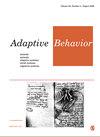Walking in Social Groups: Role of Intra-Group Interactions
IF 1.3
4区 计算机科学
Q4 COMPUTER SCIENCE, ARTIFICIAL INTELLIGENCE
引用次数: 0
Abstract
Interestingly, the interactions between members of a social group and across people of different social groups often happen through mutual understanding and reciprocate behaviour by means of gestures or eye contact. A controlled laboratory experiment is used to test the effect of interactions between members of a social group and across social groups on the walk dynamics of people. This study tries to discover the trade-off made by people between the need to communicate/interact between group members and the need to avoid collision with opposing pedestrians in a bidirectional flow. Thirty adults participated in a series of controlled experiments. The individuals and group characteristics were compared to study the effect of social groups. Spatial patterns/group formations, average walking speeds, and deviation from the desired direction of motion were assessed. The analysis shows that time to cross the platform is the least when triads adopt the river and inverted V group formations. In contrast, V and line-abreast group formations require slightly more time and are better suited to promote interactions between the group members. Irrespective of the initial formation adopted by participants, there is a higher tendency for the groups to shift to river formation or inverted V formations. This may be a result of the higher group speeds observed in the Inverted V and river formations, which accelerates their progress in the direction of motion. The understanding of walking dynamics of social groups from this study can enable better planning of pedestrian facilities and crowded events.在社会群体中行走:群体内互动的作用
有趣的是,一个社会群体的成员之间以及不同社会群体的人之间的互动往往是通过相互理解和手势或眼神交流的方式进行的。一项对照实验室实验用于测试一个社会群体成员之间和跨社会群体之间的互动对人们行走动力学的影响。本研究试图发现人们在群体成员之间沟通/互动的需要和避免在双向流动中与对面行人碰撞的需要之间所做的权衡。30名成年人参加了一系列对照实验。将个体和群体特征进行比较,以研究社会群体的影响。评估了空间模式/群体形成、平均步行速度和与所需运动方向的偏差。分析表明,当三合会采用河流和倒V形队形时,越台时间最少。相比之下,V形和线形并排的小组需要更多的时间,更适合促进小组成员之间的互动。无论参与者采用的初始地层如何,这些组都有更高的趋势转向河流地层或倒V形地层。这可能是在倒转的V形和河流地层中观察到的较高群速度的结果,这加速了它们在运动方向上的前进。通过这项研究了解社会群体的步行动态,可以更好地规划步行设施和拥挤的活动。
本文章由计算机程序翻译,如有差异,请以英文原文为准。
求助全文
约1分钟内获得全文
求助全文
来源期刊

Adaptive Behavior
工程技术-计算机:人工智能
CiteScore
4.30
自引率
18.80%
发文量
34
审稿时长
>12 weeks
期刊介绍:
_Adaptive Behavior_ publishes articles on adaptive behaviour in living organisms and autonomous artificial systems. The official journal of the _International Society of Adaptive Behavior_, _Adaptive Behavior_, addresses topics such as perception and motor control, embodied cognition, learning and evolution, neural mechanisms, artificial intelligence, behavioral sequences, motivation and emotion, characterization of environments, decision making, collective and social behavior, navigation, foraging, communication and signalling.
Print ISSN: 1059-7123
 求助内容:
求助内容: 应助结果提醒方式:
应助结果提醒方式:


